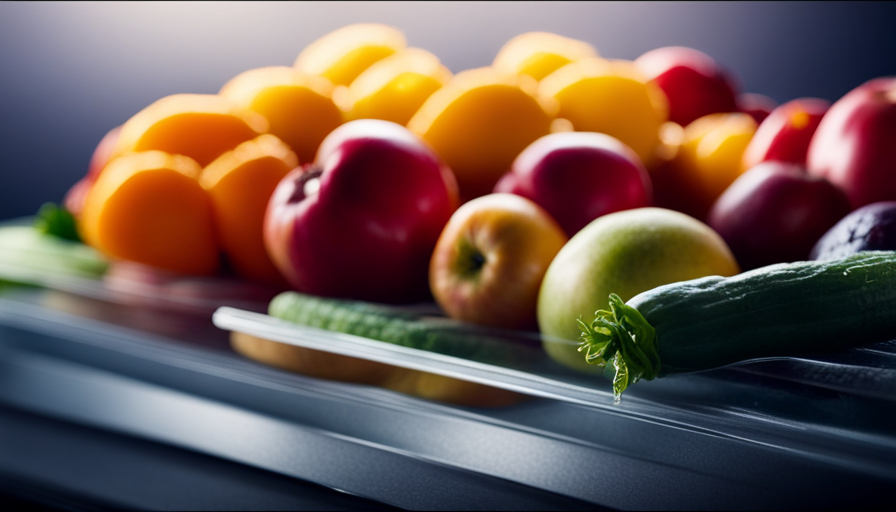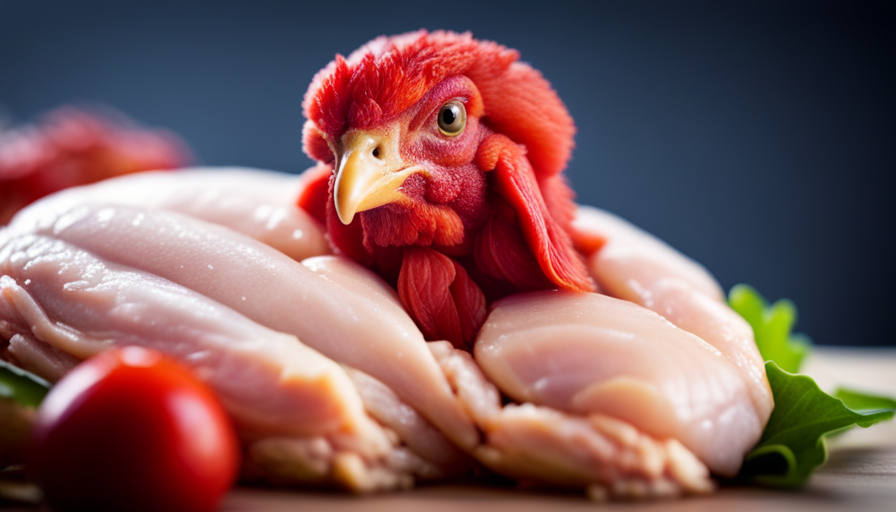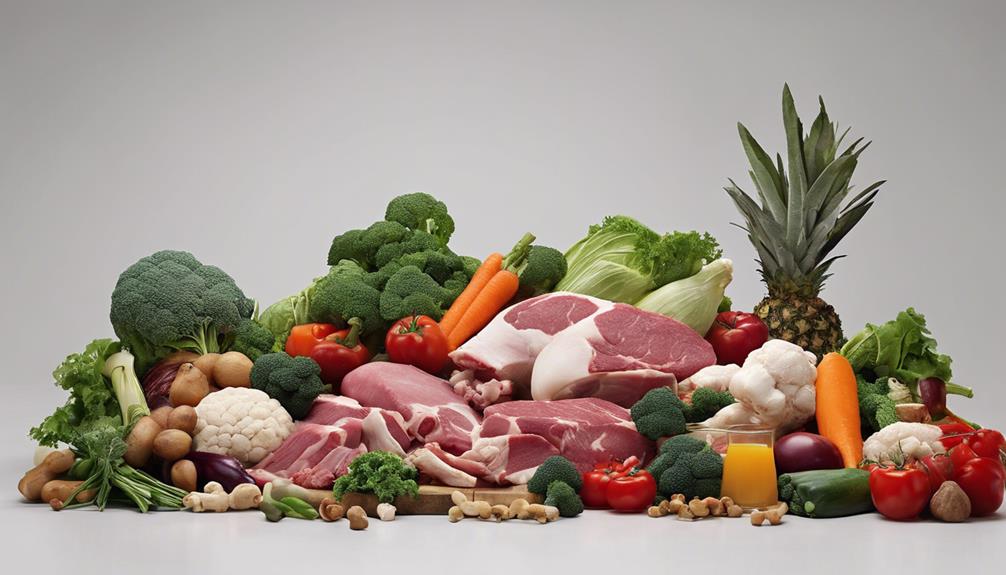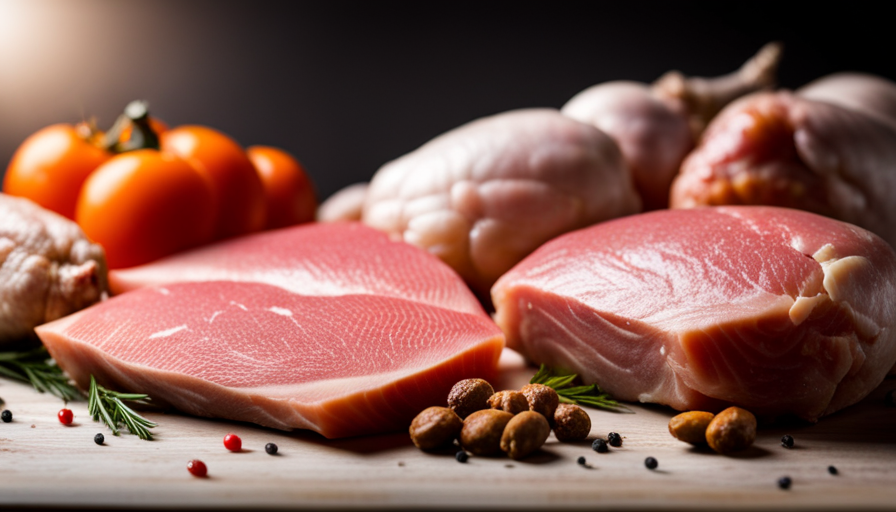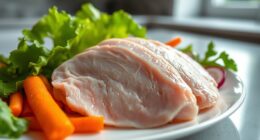Have you ever thought about how you can retain the nutrients in your food while also making tasty and nutritious snacks? You should consider using a raw food dehydrator.
This innovative kitchen appliance is based on the theory that by removing moisture from food at low temperatures, you can retain its vital nutrients and enzymes. With a raw food dehydrator, you can easily extend the shelf life of your produce, enhance the flavor and texture of your meals, and even make homemade jerky.
Not only does this save you money in the long run, but it also allows you to customize your recipes and flavors to suit your preferences. Whether you’re a nutritionist, food scientist, or simply someone who wants to promote a raw food lifestyle, a raw food dehydrator is an essential tool in your kitchen arsenal.
Discover the many benefits of this incredible appliance and start enjoying the healthiest and tastiest snacks today.
Key Takeaways
- Raw food dehydrators preserve nutrients and enzymes in food by removing moisture at low temperatures.
- Dehydrating food extends the shelf life of produce and enhances the flavor and texture of meals.
- Using a raw food dehydrator saves money in the long run and promotes a raw food lifestyle.
- Dehydrated fruits and vegetables retain most of their original nutrients, making them a healthy alternative to store-bought snacks.
Preserving Nutrients in Food
Who doesn’t love the idea of preserving all those precious nutrients in our food? As a nutritionist, it’s crucial to understand the importance of nutrient retention and food preservation.
That’s where a raw food dehydrator comes in. This innovative kitchen tool allows you to remove moisture from your food while maintaining its nutritional value.
When we cook food at high temperatures, especially through methods like boiling or frying, we often end up losing a significant amount of nutrients. Heat-sensitive vitamins, such as vitamin C and B vitamins, can be particularly affected. However, by using a raw food dehydrator, you can preserve these nutrients and enjoy a healthier diet.
The dehydration process involves gently removing moisture from fruits, vegetables, and other foods, without subjecting them to extreme heat. This helps to retain the vitamins, minerals, and enzymes that are essential for our bodies to function optimally.
By dehydrating your food, you can also extend its shelf life, reducing waste and saving money in the long run.
In addition to nutrient retention, using a raw food dehydrator also enhances the flavors of the food. The removal of moisture intensifies the natural taste, making your snacks and ingredients more delicious. So, not only are you preserving nutrients, but you’re also enhancing the overall culinary experience.
A raw food dehydrator is a valuable tool for those who want to preserve the nutrients in their food while enjoying a wide range of delicious snacks and ingredients. By dehydrating your food, you can maintain its nutritional value, extend its shelf life, and enhance its flavors. So, why not give it a try and join the movement towards healthier eating?
Creating Healthy Snacks
To make nutritious snacks, you can easily whip up tasty treats using this handy kitchen appliance. Creating healthy snacks has never been easier with a raw food dehydrator. Not only does it help preserve the nutrients in your food, but it also allows you to get creative with your snacks.
When it comes to healthy snack ideas, the options are endless with a dehydrator. You can make fruit leather by blending together fresh fruits and spreading the mixture onto the dehydrator trays. This is a great way to satisfy your sweet tooth without any added sugars or preservatives.
Another idea is to make kale chips by tossing kale leaves in a little olive oil and seasoning before dehydrating them. These crispy chips are packed with vitamins and minerals, making them a healthier alternative to traditional potato chips.
Incorporating a raw food dehydrator into your diet can also provide you with the benefits of a raw food diet. Raw foods are known for being rich in enzymes, which are essential for digestion and nutrient absorption. By dehydrating fruits, vegetables, and nuts at low temperatures, you can retain these important enzymes and enjoy the health benefits they provide.
A raw food dehydrator is a versatile tool that can help you create a variety of healthy and delicious snacks. From fruit leather to kale chips, the possibilities are endless. Incorporating these snacks into your diet can provide you with the benefits of a raw food diet, ensuring you’re getting the most out of your food. So go ahead, get creative and enjoy the goodness of raw food snacks!
Extending Shelf Life of Produce
Extend the lifespan of your fresh produce and reduce waste by learning simple tricks to prolong their shelf life. As a nutritionist and food scientist, I can provide you with expert advice on how to maximize the availability of your food while minimizing spoilage.
One effective method to achieve this is by using a raw food dehydrator. A raw food dehydrator is a valuable tool that removes moisture from fruits, vegetables, and other produce, extending their shelf life. By dehydrating your food, you can preserve it for longer periods without compromising its nutritional value. Dehydration helps to inhibit the growth of bacteria, yeast, and mold that cause spoilage. It also concentrates the flavors, making your produce even more delicious.
By using a raw food dehydrator, you can increase the availability of food in your pantry. With dehydrated fruits and vegetables, you can have an abundant supply of nutritious snacks all year round. Additionally, dehydrated produce is lightweight and takes up less space, making it easy to store and transport.
Minimizing food spoilage is crucial to reduce waste and save money. With a raw food dehydrator, you can enjoy the benefits of fresh produce for an extended period. So, invest in a dehydrator today and start enjoying the convenience and health benefits it offers.
Enhancing Flavor and Texture
Enhance the flavor and texture of your produce by using a dehydrator, allowing you to create delicious and unique snacks that’ll impress your taste buds.
Dehydrating fruits not only extends their shelf life but also intensifies their natural sweetness and enhances their overall flavor profile. Here are three reasons why using a raw food dehydrator can take your flavorful recipes to the next level:
-
Concentrated Flavor: Dehydrating fruits removes water content, resulting in a concentrated burst of flavor. This process intensifies the natural sugars present in the fruit, making them sweeter and more enjoyable to eat. Imagine biting into a dried mango slice that bursts with a rich, tropical sweetness, or savoring a chewy dried strawberry that encapsulates the essence of summer.
-
Enhanced Texture: Dehydrated fruits develop a delightful chewiness that adds a satisfying texture to your snacks. The removal of moisture gives them a slightly denser and more substantial bite, creating a unique mouthfeel experience. Whether you enjoy a crisp apple chip or a plump raisin, the texture of dehydrated fruits elevates your snacking pleasure.
-
Versatile Ingredient: Dehydrated fruits can be used in various recipes to add a burst of flavor and a touch of natural sweetness. From granola bars and trail mixes to homemade energy balls, incorporating dehydrated fruits into your culinary creations adds a delightful twist that’ll impress your friends and family.
Incorporating a raw food dehydrator into your kitchen arsenal allows you to unlock the full potential of your produce, creating flavorful snacks that are both nutritious and satisfying. So, start experimenting with dehydrating fruits to elevate your recipes and embark on a flavorful journey you won’t regret.
Making Homemade Jerky
Get ready to unleash your inner chef and create mouthwatering homemade jerky that’ll have your taste buds dancing with delight.
Making homemade jerky is a fantastic way to utilize your raw food dehydrator and explore a variety of flavors and textures. With the right homemade marinades and different meat options, you can create a jerky that’s not only delicious but also packed with nutrition.
When it comes to homemade marinades, the options are endless. You can experiment with different combinations of ingredients like soy sauce, Worcestershire sauce, honey, garlic, and spices to create your own unique flavor profile. Marinating the meat before dehydrating it won’t only enhance the taste but also tenderize the meat, making it easier to chew.
Speaking of meat options, you have a wide range to choose from. Beef is the most common choice for jerky, but you can also use other meats like turkey, chicken, or even fish. Each meat option will bring its own distinct flavor and texture to the jerky, allowing you to explore different culinary possibilities.
So, grab your raw food dehydrator and get ready to embark on a jerky-making adventure. With homemade marinades and different meat options, you can create a snack that’s not only delicious but also nutritious. Your friends and family will be impressed with your culinary skills, and your taste buds will thank you for the flavorful journey.
Reducing Food Waste
Don’t let your leftovers go to waste, find creative ways to repurpose them and make a positive impact on the environment. When it comes to reducing food waste, implementing sustainable practices is key. By utilizing a raw food dehydrator, you can transform your leftover fruits, vegetables, and herbs into tasty snacks that can be enjoyed for weeks to come.
Food waste is a significant issue that contributes to greenhouse gas emissions and strains our already limited resources. By dehydrating your leftovers, you’re preventing them from ending up in a landfill and reducing your carbon footprint. Moreover, dehydrated foods have a longer shelf life, allowing you to consume them at your convenience without worrying about spoilage.
When using a raw food dehydrator, it’s essential to follow proper food safety guidelines. Ensure that your leftovers are fresh and free from any mold or signs of spoilage before dehydrating them. Additionally, be mindful of the temperature and time required for each type of food to ensure optimal results.
Repurposing your leftovers through dehydration not only reduces food waste but also offers a variety of nutritional benefits. Dehydrated fruits and vegetables retain most of their original nutrients, making them a healthy alternative to store-bought snacks. So next time you find yourself with extra produce, don’t toss it away. Instead, grab your raw food dehydrator and embark on a sustainable journey towards reducing food waste.
Easy Meal Preparation
Simplify your cooking routine and save time by easily preparing meals in advance, even if you think you don’t have enough time in your busy schedule.
With a raw food dehydrator, you can create quick meal options that are both nutritious and delicious. By dehydrating fruits, vegetables, and even meats, you can easily have a variety of ingredients on hand for easy meal preparation.
One of the biggest advantages of using a raw food dehydrator for meal prep is the time-saving aspect. You can dehydrate large batches of fruits and vegetables at once, ensuring that you always have a supply of ready-to-use ingredients. Simply soak the dehydrated ingredients in water or add them directly to your recipes, and they’ll rehydrate quickly, allowing you to whip up meals in no time.
Additionally, dehydrating meats can be a great way to add flavor and texture to your dishes. By dehydrating slices of chicken, beef, or fish, you can create jerky-like strips that can be added to salads, wraps, or stir-fries for a protein-packed meal. This eliminates the need for cooking the meat separately, saving you even more time.
Incorporating a raw food dehydrator into your meal prep routine is a game-changer. It allows you to have quick meal options readily available, making it easier to stick to your healthy eating goals, even on busy days. So, why not give it a try and experience the time-saving benefits for yourself?
Cost Savings
Now that you’ve learned about the easy meal preparation benefits of a raw food dehydrator, let’s dive into another advantage: cost savings. By investing in a raw food dehydrator, you can adopt money-saving tips and create budget-friendly recipes that’ll benefit both your health and your wallet.
-
Preserve seasonal produce: With a raw food dehydrator, you can easily preserve excess fruits and vegetables when they’re in season and at their lowest prices. By dehydrating them, you can enjoy them all year round without worrying about spoilage.
-
Reduce food waste: By dehydrating your fruits, vegetables, and herbs, you can extend their shelf life significantly. This means less food waste and more savings for you.
-
Make your own snacks: Instead of buying expensive packaged snacks, you can create your own healthy and budget-friendly alternatives using the dehydrator. From kale chips to fruit leathers, the possibilities are endless.
-
Repurpose leftovers: Leftovers can be transformed into delicious and nutritious dehydrated meals. By dehydrating soups, stews, or even cooked meats, you can create convenient, shelf-stable options that’ll save you both time and money.
Investing in a raw food dehydrator not only allows you to enjoy the benefits of easy meal preparation but also opens up a world of money-saving opportunities and budget-friendly recipes. Start dehydrating your way to a healthier and more economical lifestyle today.
Customizing Recipes and Flavors
Get ready to unleash your creativity in the kitchen by customizing recipes and flavors to suit your taste preferences and dietary needs. With a raw food dehydrator, the possibilities are endless when it comes to customizing flavors and experimenting with ingredients.
One of the greatest advantages of using a raw food dehydrator is the ability to create your own unique flavors. You can easily adjust the seasonings and spices in your recipes to create a taste that’s perfectly tailored to your liking. Whether you prefer a spicy kick or a subtle sweetness, the choice is yours.
Furthermore, a raw food dehydrator allows you to experiment with different ingredients. You can try out new fruits, vegetables, and herbs to add a burst of flavor to your dishes. By dehydrating these ingredients, you can intensify their natural taste and create a whole new culinary experience.
Not only does customizing recipes and flavors enhance the enjoyment of your meals, but it also allows you to address your specific dietary needs. Whether you follow a gluten-free, dairy-free, or vegan diet, a raw food dehydrator gives you the freedom to create dishes that fit your lifestyle. You can substitute ingredients and make adjustments to ensure that your meals align with your dietary restrictions.
A raw food dehydrator empowers you to be the master of your kitchen by allowing you to customize flavors and experiment with ingredients. So go ahead and let your culinary imagination run wild!
Promoting a Raw Food Lifestyle
Embrace a whole new way of living and watch as your health transforms before your very eyes. By promoting a raw food lifestyle, you’re not only nourishing your body with wholesome and unprocessed ingredients, but you’re also reaping the countless benefits of raw food.
Raw food recipes are centered around fresh fruits, vegetables, nuts, and seeds, which are packed with essential nutrients and enzymes that are often lost during cooking.
One of the key benefits of embracing a raw food lifestyle is the increased intake of vitamins and minerals. Raw fruits and vegetables are rich in antioxidants, which help fight against harmful free radicals and reduce the risk of chronic diseases. Additionally, the high fiber content in raw foods aids in digestion and promotes a healthy gut.
Another advantage of incorporating raw food into your diet is the potential for weight loss. Raw food is naturally low in calories and high in water content, making it a satisfying and nutritious option for those looking to shed a few pounds. Moreover, the enzymes present in raw foods facilitate efficient digestion and metabolism, further supporting weight management.
Promoting a raw food lifestyle is a powerful way to prioritize your health and well-being. By exploring and experimenting with raw food recipes, you can unlock a world of flavors and nutrients that’ll invigorate your body and mind.
So, why wait? Start your raw food journey today and experience the transformative benefits for yourself.
Frequently Asked Questions
How does a raw food dehydrator work?
A raw food dehydrator works by removing the moisture from food at low temperatures, typically around 115°F, to preserve its nutritional value. This process helps to extend the shelf life of raw foods while maintaining their enzymes and vitamins.
The advantages of using a raw food dehydrator include preserving nutrients, enhancing flavors, and creating a convenient, portable snack. However, one disadvantage is that it can be time-consuming, as the dehydration process can take several hours or even overnight.
Are there any specific foods that should not be dehydrated?
As a nutritionist and food scientist, it’s important to be cautious when dehydrating certain foods. Some specific foods shouldn’t be dehydrated due to various reasons.
For example, foods with high water content like cucumbers or watermelon may not dehydrate well and could become mushy. Additionally, foods that are already dry, such as crackers or chips, don’t benefit from dehydration and may become too brittle.
It’s essential to consider the texture and composition of foods before deciding to dehydrate them.
Can a raw food dehydrator be used for other cooking methods, such as baking or steaming?
Did you know that a raw food dehydrator can be used for more than just dehydrating? In fact, it can also be used for baking and steaming!
This versatile kitchen appliance utilizes low heat and circulating air to gently cook your food, making it perfect for creating delicious baked goods or steamed dishes.
So not only can you enjoy the benefits of dehydrated foods, but you can also expand your culinary repertoire with baking and steaming methods using a raw food dehydrator.
How long does it typically take to dehydrate food in a raw food dehydrator?
Dehydrating food in a raw food dehydrator typically takes several hours, depending on the type and thickness of the food. It’s important to ensure that the food is completely dry before storing it to prevent spoilage.
Dehydrated food can be stored in airtight containers in a cool, dark place. Using a raw food dehydrator offers several benefits, such as preserving the nutritional content of the food and allowing for longer shelf life without the need for preservatives.
Are there any safety concerns or precautions to take when using a raw food dehydrator?
When using a raw food dehydrator, it’s important to be aware of safety concerns and take necessary precautions. One of the main concerns is the risk of bacterial growth if the food isn’t dehydrated properly. To avoid this, make sure that the dehydrator is clean and sanitized before each use.
Additionally, it’s crucial to follow the recommended temperature and time guidelines for different types of food to prevent the growth of harmful bacteria and ensure food safety.
Is Using a Dehydrator a Good Way to Store Raw Food in the Fridge?
Using a dehydrator can be a great option for storing raw food in the fridge. It helps to remove moisture from the food, preventing bacteria growth and spoilage. This method can extend the shelf life of fruits, vegetables, and meats, making it a convenient and effective way of storing raw food in the fridge.
Conclusion
So, now you understand the benefits of using a raw food dehydrator. By preserving the nutrients in your food and creating healthy snacks, extending the shelf life of produce, enhancing flavor and texture, making homemade jerky, and promoting a raw food lifestyle, you can truly revolutionize your culinary experience.
But perhaps you’re thinking, "Doesn’t dehydrating food take away its natural moisture?" Well, think of it this way: just like the warm sun gently drying out a juicy piece of fruit, a raw food dehydrator carefully removes moisture while maintaining all the essential nutrients, resulting in a delicious and nutritious treat.

